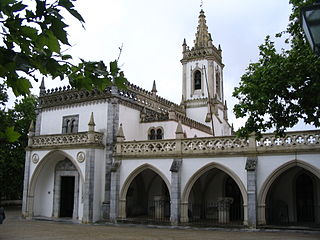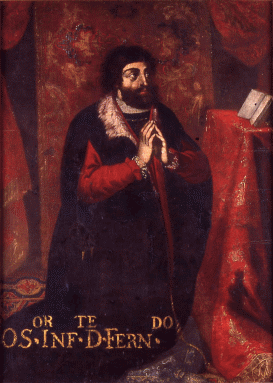
Sóror Mariana Alcoforado was a Portuguese nun living in the convent of the Poor Clares in Beja, Portugal.

Beja is a city and a municipality in the Alentejo region, Portugal. The population in 2011 was 35,854, in an area of 1,146.44 km2 (442.64 sq mi). The city proper had a population of 21,658 in 2001.

Infante Ferdinand, Duke of Viseu and Beja was the third son of Edward, King of Portugal and his wife Eleanor of Aragon.

Infante Francisco, Duke of Beja was a Portuguese infante (prince) son of Peter II, King of Portugal, and his second wife, Maria Sofia of the Palatinate.

Dona Maria Francisca Isabel of Savoy was Queen of Portugal during her marriage to King Dom Afonso VI from 2 August 1666 to 24 March 1668 and, as the wife of Afonso's brother King Dom Peter II, from 12 September 1683 until her death in December that year. She married Afonso VI at the age of 20; because the marriage was never consummated, she was able to obtain an annulment. On 28 March 1668, she married the King's brother Infante Dom Peter, Duke of Beja, who was appointed prince regent the same year due to Afonso's perceived incompetence. She became queen a second time when Afonso died and Peter succeeded his brother, but she herself died three months later.

Pousadas de Portugal is a chain of luxury, traditional or historical hotels in Portugal. Formerly run by the Portuguese State, they are now run by the Pestana Group, which in September 2003 won a public bid for the sale of 37.6% of parent company Enatur and for a 40-year running concession. It is a member of the Historic Hotels of Europe.

Portuguese Gothic architecture is the architectural style prevalent in Portugal in the Late Middle Ages. As in other parts of Europe, Gothic style slowly replaced Romanesque architecture in the period between the late 12th and the 13th century. Between the late 15th and early 16th century, Gothic was replaced by Renaissance architecture through an intermediate style called Manueline.
João Pedro Santa-Rita is a Portuguese architect.

José António Nunes Mexia Beja da Costa Falcão is a Portuguese art historian, museum curator and educator.

The Castle of Beja is a medieval castle in the civil parish of Beja, municipality of Beja, Portuguese district of Beja.

The Pantheon of the House of Braganza, also known as the Pantheon of the Braganzas, is the final resting place for many of the members of the House of Braganza, located in the Monastery of São Vicente de Fora in the Alfama district of Lisbon, Portugal. The pantheon's burials have included Portuguese monarchs, Brazilian monarchs, a Romanian monarch, queen consorts of Portugal, and notable Infantes of Portugal, among others.
Cristóvão de Morais was a 16th-century Portuguese court painter for the kings John III of Portugal and Sebastian I of Portugal. He painted numerous portraits for the kings, queens, and princes of Portugal.

The Royal Palace of Évora, also known as the Royal Palace of São Francisco and the Palace of King Manuel I, is a former royal residence of the Kings of Portugal, in Évora, the capital of Alentejo.

The Museum of Christian Art, in the former colonial capital of Old Goa, is a museum of Christian art. The museum reopened on 23 May 2022 after significant upgrades.
Mother Mariana of the Purification was a nun of the Carmelite Order of the Ancient Observance who, having been born in Lisbon, Portugal, and lived and professed her religious vows at the Carmelite Convent of Our Lady of Hope in Beja, Portugal, died with the odor of sanctity.

Mariana is the 1997 second novel of Katherine Vaz, originally written in English, published by Flamingo/HarperCollin. The novel was selected by the Library of Congress as one of the Top 30 International Books of 1998. The novel has been translated into more than six languages including Portuguese, Italian, and Greek.

The Castle of Moura, is a Portuguese medieval castle in civil parish of Moura e Santo Amador, in the municipality of Moura, in the district of Beja.
D. João of Braganza, Duke of Abrantesjure uxoris, more commonly known as João da Bemposta, was a legitimized natural son of Infante Francisco, Duke of Beja. A grandson of King Pedro II of Portugal, and thus a member of the House of Braganza, João held various offices during the reigns of his uncle King João V and cousin Queen Maria I.

The Convent of Santo Domingo is a convent of the Dominican Order in the city of Cusco, Peru. Spanish colonists built it on top of Coricancha, the most important Inca temple of the capital of the people's empire.















